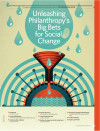It has become clear to us at the JPB Foundation that complex social issues like poverty cannot be solved by single grantees working alone. Instead, we have found that we can help them proceed faster and further in their missions when we take a “hub and network” approach to funding: Rather than funding one organization and moving on, we place multiple bets on a centrally positioned grantee, the hub, that has the capacity to serve as the issue-area focal point of our grantmaking. We then build a constellation of additional investments around them, creating a network of organizations that work collaboratively towards a common goal.
Unleashing Philanthropy’s Big Bets for Social Change

This collection of articles, sponsored by The Bridgespan Group, explores how big-bet philanthropy is changing the ways that social entrepreneurs, nonprofit organizations, donors, and advisors are working to have an impact on major social challenges.
-
Introduction to Unleashing Philanthropy’s Big Bets for Social Change
-
Becoming Big Bettable
-
Reimagining Institutional Philanthropy
-
Big Bets Are Important. But So Is a Big Heart.
-
Big Gift, Big Impact
-
Renewing Common Purpose and Collective Action
-
Empowering Nonprofits
-
Hacking the Bias in Big Bets
-
Doing More With Big Bets
-
Learning From Competition
-
From Promising Model to Major Investment
-
Big Bets, 2017-2018
-
Investing in Population-Level Change
-
Profiles of Big Bets
For example, JPB has made big investments in a movement-building organization called Community Change. Community Change acts as a hub organization in the foundation’s poverty-prevention portfolio, and we have funded a network of other nonprofits, whose work is distinct but complementary, including the Center on Budget and Policy Priorities, the National Employment Law Project, and the Sargent Shriver National Center on Poverty Law. This approach helps Community Change make progress on its ambitious goals, in part because network grantees assist them with critical services and expertise, including access to community contacts, policy development, legal research, and advocacy that they would otherwise be without.
Our funding to a network of organizations is designed to encourage them to come together, solve common problems, and act in concert to advance the social causes they are collectively working to address. The approach yielded several new partnerships for Community Change, including working with the New Venture Fund (NVF) and the Center on Budget and Policy Priorities to establish The Safety Net Defense Fund, which protects key anti-poverty programs by raising public awareness of threats to such critical elements of the safety net as the Affordable Care Act, Medicaid, and the Supplemental Nutrition Assistance Program. Importantly, the Safety Net Defense fund was designed to attract other foundations and has enabled funders to act collectively through NVF, its hub.
We also have hub organizations at the center of our work in other program areas, including energy efficiency, environmental health, access to nature, and health equity. Managed carefully, we believe this model yields tangible benefits for our hub and network partners, just as it offers rewards for us and other funders. Here is how the model works:
The Hub
Designating one grantee as the hub increases the reach of our core grantees by making sure there are other organizations out there to support them. Instead of allowing them to sink or swim by themselves, we can help them swim and succeed.The Network
Each network organization has an independent mission that complements the goals of our hub. Ideally, our approach supports the network by fostering an ecosystem where these organizations all meet and interact. In a sense, the hub and network model provides a structured space that gives leaders and other stakeholders in a field an opportunity to think and plan together, with each taking the lead in their areas of strength.Donors
The hub and network approach expands the variety of organizations we can work with in a region or program area. Even more notably, it gives JPB the tools we need to make big bets more intelligently—to experiment with collaborative models and pooled funds and to participate in joint decision-making with other funders—all while making the most of what each organization does best.
For example, JPB seeded a program, Energy Efficiency for All (EFFA), that is dedicated to linking the energy and housing sectors together to make the benefits of energy efficiency available to millions of low-income families. This was an experiment in network funding: We made a grant to the Natural Resources Defense Council, the Energy Foundation, and National Housing Trust so that the organizations would work together to lower energy rates in low-income communities. They wrote one proposal and provided one consolidated progress report. We have supported additional organizations such as Elevate Energy, New Ecology, and the American Council for an Energy-Efficient Economy, which operate as a network with EEFA, along with the Network for Energy, Water, and Health in Affordable Buildings, which was created specifically for this purpose.
The hub and network model has opened up a way for these organizations to collaborate and bring complementary experience to bear on a common challenge. It also encouraged several of them to work in affordable housing for the first time. The results have been exemplary. For example, utility companies that participated in this work have so far given back more than $400 million in concessions to low income communities, and the work has spread from 12 states to 17. In this case, as well as with Community Change and others, we have seen how this approach increases the impact of our funding.
Rarely can widespread change happen by virtue of the actions of one organization acting alone. More than anything, I hope the hub and network approach can be seen as a new path to help donors make the most of their big bets by encouraging grantees to join forces to achieve greater results.
Support SSIR’s coverage of cross-sector solutions to global challenges.
Help us further the reach of innovative ideas. Donate today.
Read more stories by Barbara Picower.

